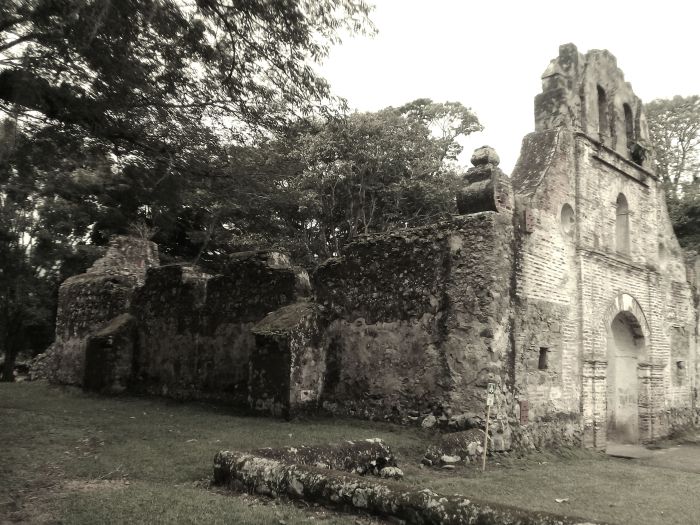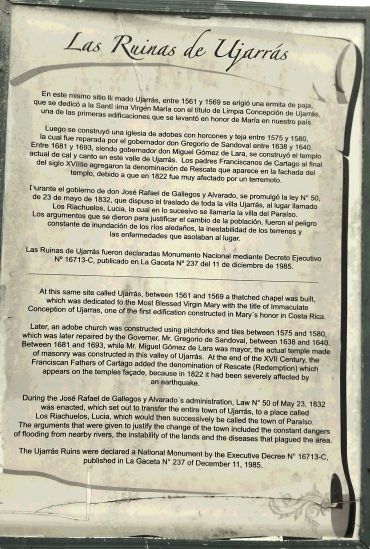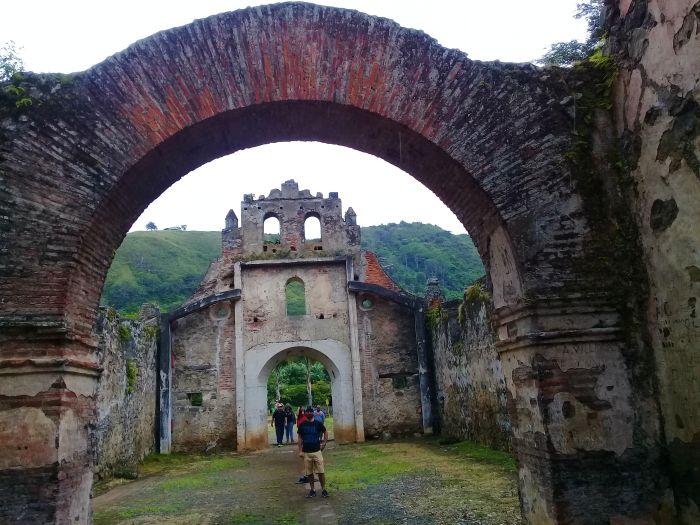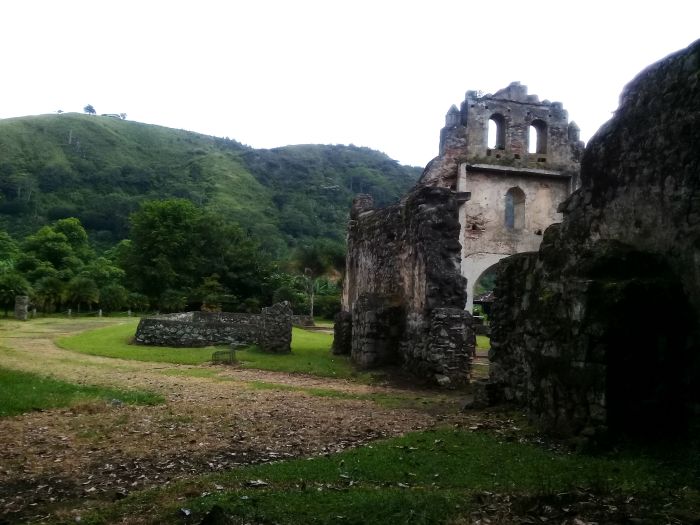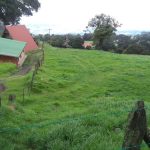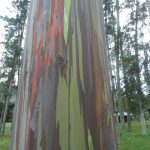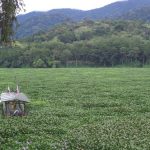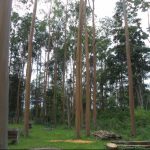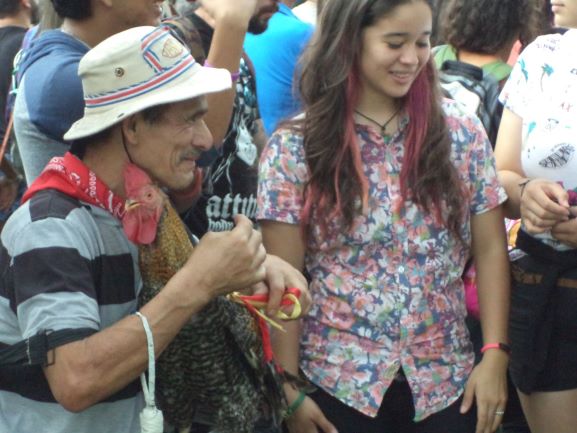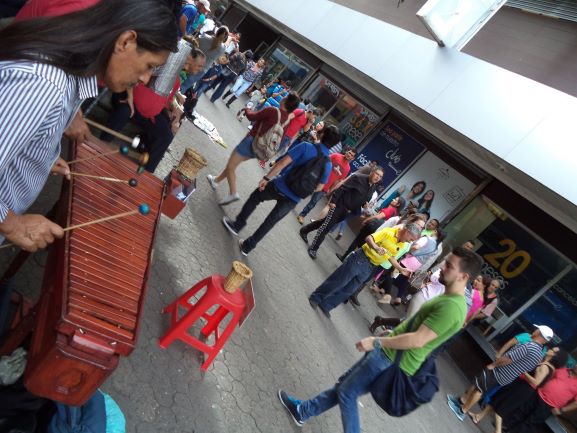The site of Las Ruinas de Ujarrás is surrounded by luscious green countryside, immaculate landscapes, winding rivers, and pristine mountains. Located deep in the Orosi valley, near the Cachí Reservoir, visitors experience a bond to the historical foundations of colonial Costa Rica as they approach the park containing the remains of the church (La Iglesia de Nuestra Señora de la Limpia Concepción). Once inside the monument grounds, you can literally touch history.
Built in the 1580’s, local legend states that a fisherman of the Huetar discovered a box containing a painting of the Virgin Mary and the church was built on this site. The Virgin Mary had thus been considered a protector of the village.
La Iglesia de Nuestra Señora de la Limpia Concepción, or what remains standing can be approached, touched, and adored. As you near the ruins, the history is palatable and the senses are alerted to the reverence that belongs to such structures throughout the world. From the stone pathway to the limestone altar, Las Ruinas de Ujarrás creates a sense of awe. Visitors walk through the large and still nearly perfect archways to the inner chamber that was once where the congregation would pray together.
Outside of the church, you see the buttresses still supporting the outer walls of the edifice. Moss grows peacefully all along the masonry. It is a scene from a fairy tale with the mountains in the background. Nearby the church stands a beautifully sad tree that is probably as old as the church itself, weeping in the common area as families picnic, play, and admire this brilliant monument.
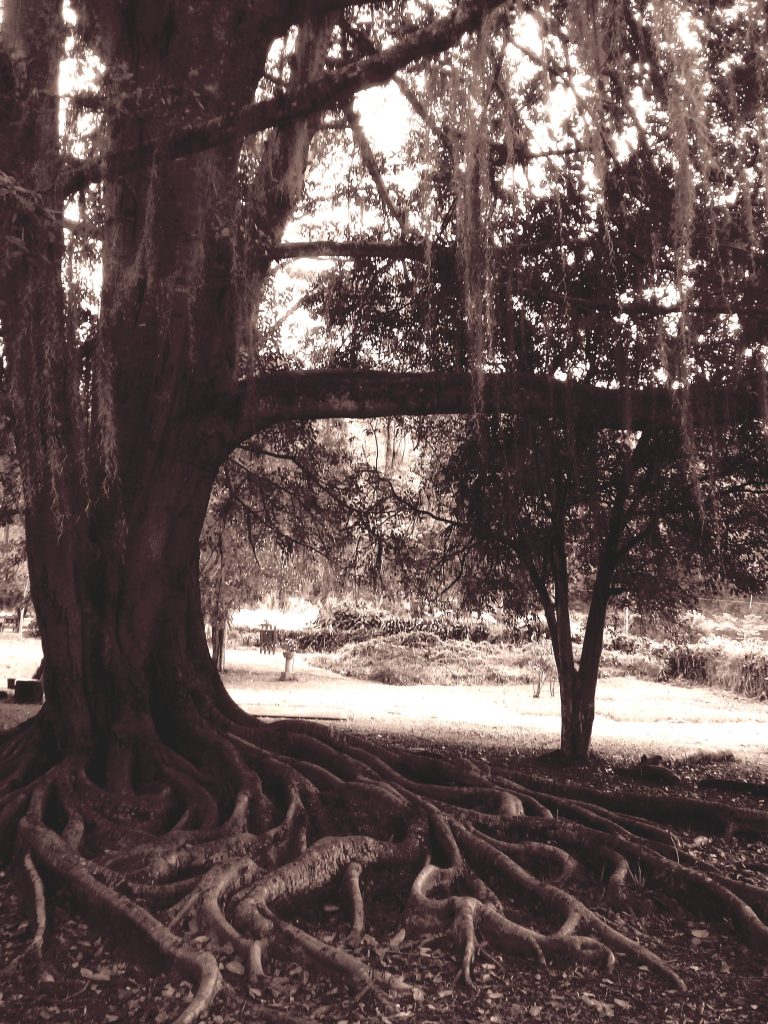
There are many places to visit in Costa Rica, but not many with such a peaceful and elegant grace as Las Ruinas de Ujarrás. For lovers of history, religion, or just serenity, this site has enough beauty to slip away into a simpler time.
Sources:
http://www.lacasonadelcafetal.com/las_ruinas_de_ujarras
Mother’s Day is celebrated in many countries throughout the world. In the US it is typically on the first Sunday of May. Although there are many shared holidays between the US and Costa Rica, Mother’s Day is not one of them. Here in Costa Rica, Mother’s Day is celebrated on August 15th. This corresponds with the Roman Catholic feast day of The Assumption of Mary. “The Assumption of Mary is a feast day recognizing the selfless and earthly life of Mary and the divinity associated with her heavenly soul,” according to http://www.prosoftnearshore.com/mothers-day-in-costa-rica-august-15/. Unlike the US, Mother’s Day in Costa Rica is National Holiday. The entire day is dedicated to celebrating our mothers.

Although it is important everywhere, the dual purpose of the holiday here in Costa Rica shows how much respect and honor we have for our mothers. There are many ways that people celebrate this very special day. Some of which include buying all types of gifts, taking mothers out for special meals, and making sure they don’t have to do any work. Mainly, the mothers that I spoke with on this day just wanted to be surrounded by family and loved ones. It is most important to make sure they know how much you love them.

“Ma! You get to celebrate twice a year while I live in Costa Rica,” I told my mother when I called in May. She loved the idea. Even though I wouldn’t be able to fly home and visit, we were able to speak on the phone for a few hours. We digitally cheers-ed each other, and drank some wine. Even though this article is a little after the fact, every day could be Mother’s Day. So please don’t forget to tell your mothers that you love and respect them. Every day would be ideal, but we know that’s not always possible.
On that note, I love you MA!

Although Costa Rica celebrates many national holidays, there are few as vibrant and culturally inclusive as the Annexation of Nicoya to Costa Rica (Guanacaste Day), which takes place on July 25th. Unlike most annexations throughout the world, the annexation of Nicoya, and thus the province of Guanacaste, was made possible by the request of the inhabitants, not some militant coup, uprising, or any such violence.
Prior to annexation in 1824, the province of Guanacaste (including the incredibly beautiful Nicoya Peninsula) was part of Nicaragua. At the time, Nicaragua was struggling with unrest and civil war which led the inhabitants of this region to request to be annexed to Costa Rica. The Central American Federation approved the request and the region became part of Costa Rica. Being that the inhabitants were the catalyst to annexation, the saying “de la patria por nuestra voluntad” (literal translation: of the country by our will) became an illustration of Costa Rican democratic values. *
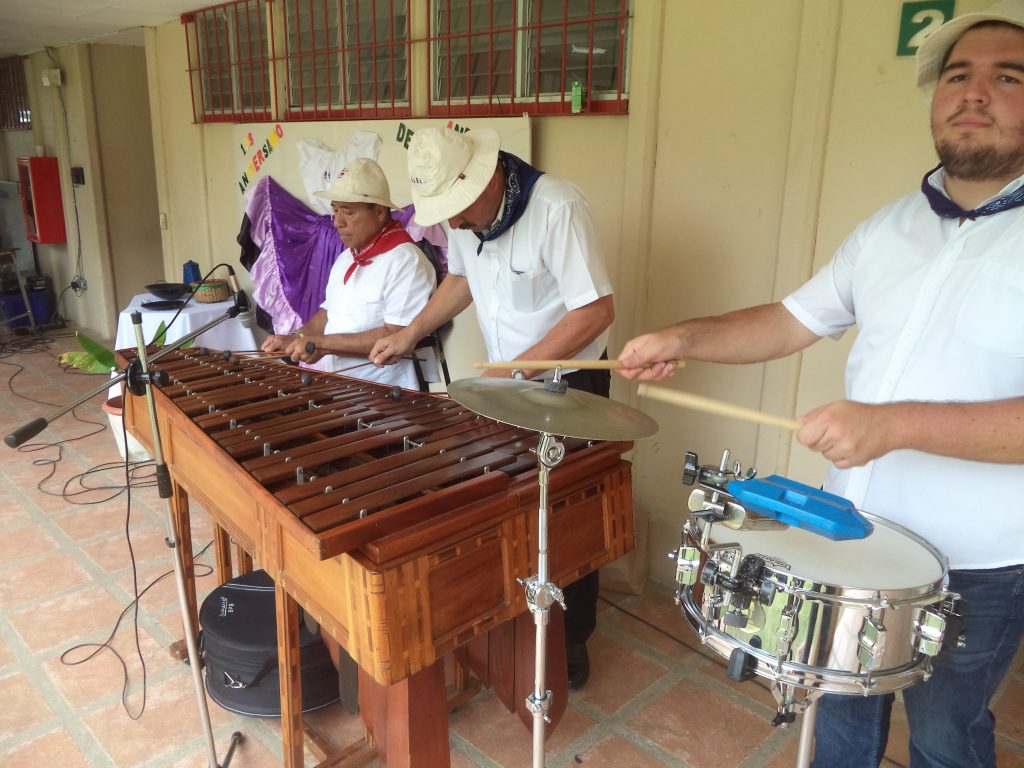
Here in San Jose, I couldn’t participate in a full-scale celebration. However, by the invitation of my students, I was able to gain access to a sample of the cultural festivities. Their colegio, or high school, held a small festival that celebrated by showcasing the cultural diversity of the entire nation.
I took the bus out to the colegio and was met with open arms. The students, as well as the administrative staff, led me to a seat in the front row to watch the final dance number. (I was there before other members of the public were allowed to visit, but missed some of the other presentations). I felt so welcome with my smile stretching from ear to ear. The dance number concluded and I began to mingle with the students and faculty. A band listlessly played classical Costa Rican music, booths were being manned by the student presenters, and the food was quickly prepared.
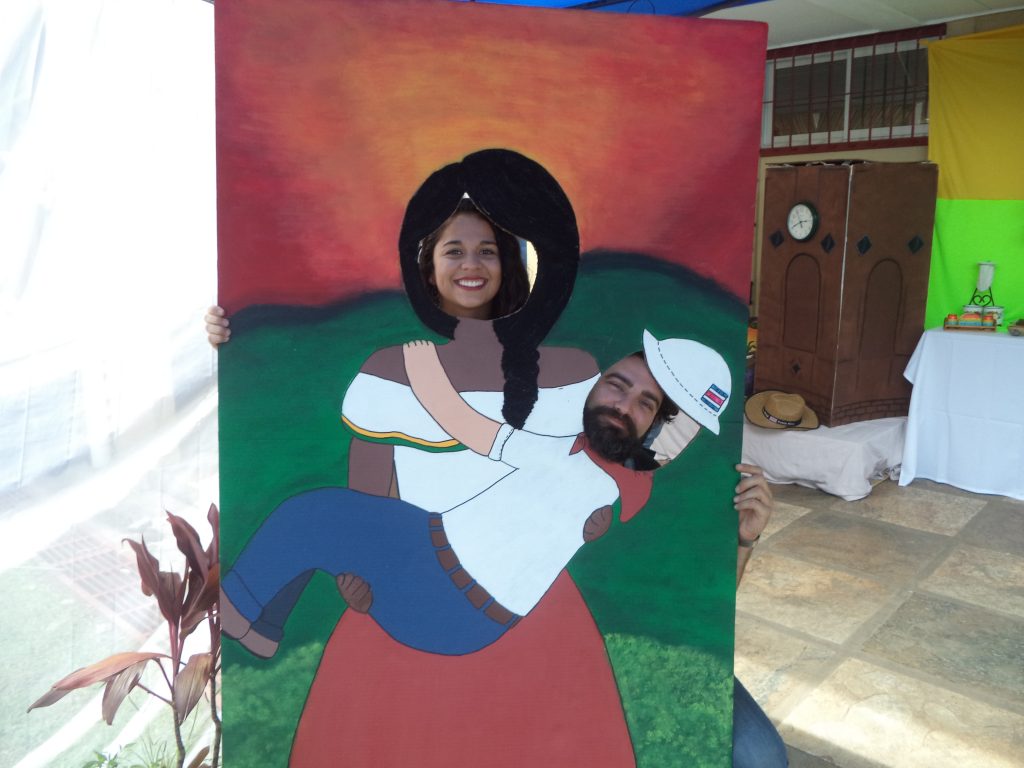
Some of my students quickly found me and began to show me around. Each class represented a different province and gave historical presentations, offered typical food, played music, and adorned decorations. Before I knew what was really happening I had a plate of corn tortillas with natilla (similar to sour cream), corn on the cob, and arroz con leche (sweet cream with rice). I tried to pay, but my students refused to allow that. I felt so incredibly welcome. After I conversed with a few more students, I made the rounds to see each of the provinces represented, listened to the histories in Spanish, and ate or drank something from each booth. The experience was incredible. I will forever be grateful to my students for inviting me to such a wonderful cultural learning experience, and for showing me an amazing time.
Not only is this National Holiday a symbol of the democratic values of Costa Rica, but it is truly a time to celebrate all of the cultures that make Costa Rica the rich and diverse country that it is today. Without seeing something like this first hand, I would have never known the importance that Costa Rica places on its very core. The people will always come first and especially their individual values and traditions.
*http://www.costaricaguides.com/guanacastes-annexation-to-costa-rica/
*http://www.guachipelin.com/blog/nicoya-annexation-to-costa-rica-july-25-1824/
Act II
After leaving the mountain, things began to improve. The cloud we occupied did not follow us down the mountain. We were able to pull over for some the best views I have seen since arriving to Costa Rica. It was also significantly warmer as we made our way down.
Then, my boss and driver had a brilliant idea. He knew of another national park with a large lake that was formed after they installed a hydro-electric power plant. Also, his kids wanted badly to go to said park for a “really awesome” swing that they have there. (It was really awesome). This heavenly place is known as Charrarra.
This park was incredible. The greens were so vibrant and the place swarmed with life. Immediately after arriving we saw a duck with her ducklings, a snake (not dangerous), herons, and other waterfowl. There were amazingly colorful and large eucalyptus trees throughout. The lake was covered in a thick-batch layer of lilies. Some of the ones close to the shore were in full bloom. They had such a majesty.
The group all enjoyed some cold beers together and then we made our way around exploring the park. We wandered down some horse paths and decided it was too risky to dodge the apple grenades. After we had climbed into a model airplane designed for 4 to 6 year-olds, used a 4 person gravity spinning swing, and played some quick toss frisbee, we made our way to a low point lookout that was stunning. Unlike the peak of the volcano, were able to see straight across all of the lake.
After a few gallivanting hours, we were all feeling hungry. We went to a local hotspot for chicharrones and enjoyed a lovely and reasonably priced meal before we made our way back to the city. The moral of the story: even a “bad” start to the day here, can end in wonder and amazement.
As buses careened through the streets, much of the city went about its Saturday as though there was nothing special. Perhaps there wasn’t. However, for the droves of people that made their way into central San Jose, the day was the height of excitement. The Festival Internacional de Las Artes was in its final stages. For 2 weeks (June 19 – July 9) FIA had captivated audiences with live music, stunning acrobatics, theatrical shorts, and so much more.
Crews of bulking men and machines were placed about the city in modes of work. The grounds were tended appropriately for the day to steal the imagination, sway the open-hearted, and dissolve the insistence upon reality. The cornucopia of culture quickly sated the hunger for collective belonging.
The walking avenues were packed. Street vendors plied their wares. You could find anything from socks, groceries, and fidget spinners to jewelry, DVDs, and pocket knives. The list is always endless. Whether looking for a quick bite or some live local accompaniment to your walk, the avenues are perfect for exploring the city life of San Jose.
Approaching the main festival staging areas, you could hear the music beating through the buildings, calling to the soul. The local pubs were filtering the thirsty in and out of the doors as breaks in the stage activity allowed time for refreshment. The courtesy offered to the traveler was incredible. Laughs were had over a few shots of chiliguaro and names exchanged. Offers were made to come sit with the perfect strangers. The demeanor here is truly “Pura Vida.”
The park and main stage at plaza de democracia were crowed with excited onlookers and music aficionados of all ages. Feet tapped, hips shook, heads bobbed. One man danced enthusiastically as the flute player on the stage hit the crescendo and the band followed suit with an invigorating folk masterpiece.
Leaving the stage area it was a short walk, about 3 minutes, to parque nacional. Here, for those not as thrilled by music, there was a pop-up mall of international and local vendors selling every type of art you could imagine. 2 more stages were also in place with live theatrical performances and physical comedy. The crowd mingled tirelessly, but as casual as though this sort of event happened every week. Lovers caressed, teenagers assembled, families played. The feeling was serene.
The FIA was and will continue to be one of the staples of the Costa Rican “summer.” There were too many activities to attend all or even most, but there is certainly something for everyone going on the entire time. To miss it, you would have had to avoid the area completely with your eyes closed, ears shut, and cynicism in full swing.


